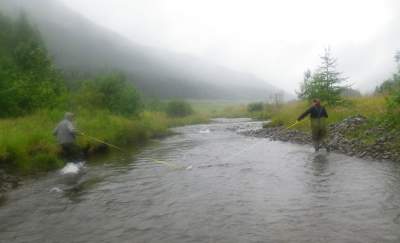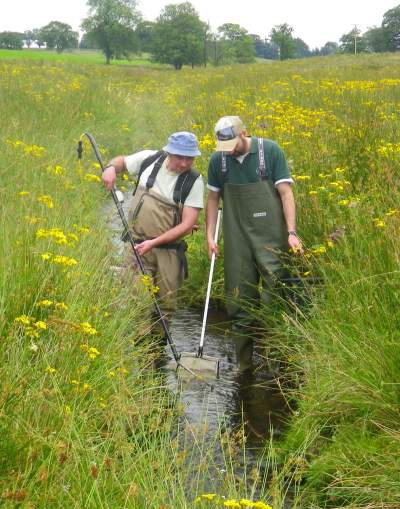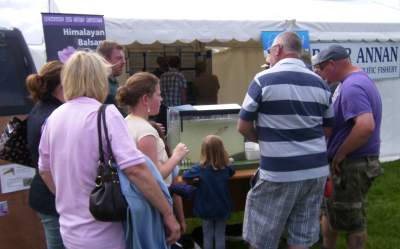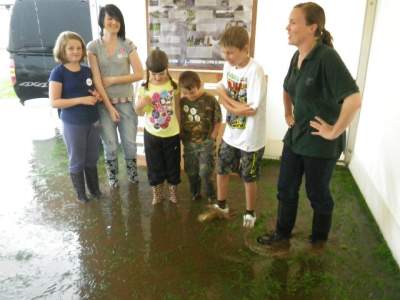
Not my real name, quite!
I have now completed my third placement (River Annan District Salmon Fishery Board) and begun at my fourth (Cree Valley Community Woodland Trust). Still waiting for summer (IS it summer?) although having said that the past 3 days have been glorious, giving some great views of the Galloway hills around my home for the next two months. More on that at a later date!
My time at the Annan fishery was time well spent. I went into this knowing not a lot about river ecosystems, and literally nothing about fishing. Sadly I still know nothing about fishing unless it involves an electric current. Some might call this cheating, but it is in fact ‘monitoring’. I didn’t quite get the angling bug, but that was partly because I wasn’t quite brave enough to ask if I could have a go. Given the number of times I managed to rip holes in my waders (a record number apparently), it probably wouldn’t have been a good idea to trust me with expensive equipment. But maybe next time! Anyway, I learned lots of other things instead.
On my first day I went along to a really good training course run by the Riverfly Partnership. This course enables members of the public to monitor the health of rivers in their area by sampling for riverfly larvae, ideally once a month. Anyone who likes rivers can get involved, not just anglers (despite being called the Anglers’ Monitoring Initiative).
Surveying is done by kick-sampling, i.e. wading into the river and disturbing sediment, holding a net downstream to catch the creatures that have been dislodged. Pretty straightforward, plus the perfect excuse to GET IN THE WATER!
After splashing about, the various invertebrates need to be identified and quantified. It’s worth kick-sampling just to see the weird animals that live in the river, like the Heptagenid that looks like a christmas tree (sort of) and the amazing cases the caddisfly larvae build. The sample is given a score based on the type and frequency of invertebrates caught. And this is all vital information for the Fisheries Trust, with a huge catchment to cover and limited man (or woman) power to cover it.
The whole idea is that if you know what is ‘normal’ for a site, then you can generate a threshold score. A result below the threshold will tell you that there’s a problem upstream (e.g. a pollution event).
Frankly, if I lived near a river I’d be signing up for this straight away. If it sounds like fun to you, ring up your local fisheries board and find out if they’re part of this scheme. The more the merrier!
The River Annan Trust now has a team of volunteers surveying the Annan catchment, which is great news. But it’s not just volunteers that do surveys of course! So the next thing to learn was how to conduct fish surveys – slight play on words there as electricity is involved, haha..
Electrofishing is really exciting – you never know what you’re going to get! My job was to try and catch the stunned fish before they floated off downstream. Sad to say I did miss a few (sorry James) and never won any fish-catching competitions, but it was so interesting! We mainly caught salmon and trout (fry and parr, i.e. small ones), stoneloach and minnows, but we also got some lampreys and an eel or two. In case anyone’s interested, the phrase ‘slippery as an eel’ is completely accurate.
I also spent quite a lot of time on invasive non-native work. Here are some things you really DO NOT WANT in your river/garden/life:
- American Signal Crayfish – if you see a cra yfish in Scotland, it should not be there. Report it. Crayfish are really bad news.
- Japanese Knotweed – the one that grows through concrete and regrows from tiny fragments of cane if cut
- Giant Hogweed – the one that burns your skin forever and grows to about 5m tall
- Himalayan Balsam – pretty flowers, good for bees but unfortunately just takes over
- American Mink – will eat all the water voles, ground-nesting birds etc
In my first week, we went to visit a particularly unfortunate gentleman who has all three invasive plants – knotweed, giant hogweed and balsam – growing in his back garden. Not good!
I spent a few days helping to survey one of the rivers in the catchment for invasive plants – not as easy as it sounds, trust me. Sadly, because I haven’t got my pesticide qualification yet, I wasn’t actually able to help control the knotweed we found. However Chris, the Annan’s Invasives Project Officer, is on the case, and is doing a great job throughout the catchment.
For my final day with the RADSFB, I went along to the Dumfries Show, where we filled our tent with a big display, complete with a tank of fish and invertebrates, and set about chatting to people about the river. It was all going swimmingly until about 2 o’clock, when the weather decided to go tropical. One hour later, it looked like we had set up our tent in a small lake. The rain and hail had been so heavy and the thunder so loud that sheltering children were quaking in their boots. A fittingly memorable end to what had been a brilliant month.





